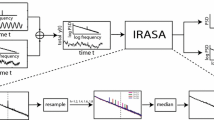Abstract
This study addresses application of Higuchi’s fractal dimension (FD) as a measure to evaluate the effect of external periodic stressor on electrical oscillations in the brain. Modulated microwave radiation was applied as a weak periodic stressor with strongly inhomogeneous distribution inside the brain. Experiments were performed on a group of 14 volunteers. Ten cycles (1 min on, 1 min off) of 450-MHz microwave radiation modulated at 40 Hz were applied. Higuchi’s FD was calculated in eight symmetric electroencephalographic (EEG) channels located in frontal, temporal, parietal, and occipital areas. FD values averaged over a group detected a small (1–2%) but statistically significant increase with exposure in all EEG channels. FD increased for 12, decreased for one, and was constant for one subject. FD showed the most remarkable effect in temporal and parietal regions of the left hemisphere where the microwave field was maximal. Changes of FD in these regions of the right hemisphere were much higher than expected in accordance with the field distribution. Correlation of FD between different EEG channels was high and retained its value in exposed conditions. Spreading of disturbance between different brain areas is supposed to be crucial for the effect of exposure on the electrical oscillations in the brain.







Similar content being viewed by others
References
Adair RK (2002) Vibrational resonances in biological systems at microwave frequencies. Biophys J 82:1147–1152
Bachmann M, Kalda J, Lass J, Tuulik V, Säkki M, Hinrikus H (2005) Non-linear analysis of the electroencephalogram for detecting effects of low-level electromagnetic fields. Med Biol Eng Comp 43:142–148
Bandettini PA (2009) What’s new in neuroimaging methods? Ann NY Acad Sci 1156:260–293
Christ A, Chavannes N, Nikoloski N, Gerber HU, Poković K, Kuster NA (2005) Numerical and experimental comparison of human head phantoms for compliance testing of mobile telephone equipment. Bioelectromagnetics 26:125–137
Cook CM, Saucier DM, Thomas AW, Prato FS (2006) Exposure to ELF magnetic and ELF-modulated radiofrequency fields: the time course of physiological and cognitive effects observed in recent studies (2001–2005). Bioelectromagnetics 27:613–627
Curcio G, Ferrara M, Moroni F, D’Inzeo G, Bertini M, De Gennaro L (2005) Is the brain influenced by a phone call? An EEG study of resting wakefulness. Neurosci Res 53:265–270
Higuchi T (1988) Approach to an irregular time series on the basis of the fractal theory. Phys D 31:277–283
Hinrikus H, Bachmann M, Lass J, Tomson R, Tuulik V (2008) Effect of 7, 14 and 21 Hz modulated 450 MHz microwave radiation on human electroencephalographic rhythms. Int J Radiat Biol 84:69–79
Hinrikus H, Bachmann M, Lass J, Karai D, Tuulik V (2008) Effect of low-frequency modulated microwave exposure on human EEG: individual sensitivity. Bioelectromagnetics 29:527–538
Hinrikus H, Karai D, Lass J, Rodina A (2010) Effect of noise in processing of visual information. Nonlinear Biomed Phys 4:5. doi:10.1186/1753-4631-4-S1-S5
Huber R, Treyer V, Borbely AA, Schuderer J, Gottselig JM, Landolt HP, Werth E, Berthold T, Kuster N, Buck A, Achermann P (2002) Electromagnetic fields, such as those from mobile phones, alter regional cerebral blood flow and sleep and waking EEG. J Sleep Res 11:289–295
IEEE Standard 1528–2003 (2003) Recommended practice for determining the peak spatial-average specific absorption rate (SAR) in the human head from wireless communications devices: measurement techniques
International Commission on Non-ionizing Radiation Protection (1998) Guidelines for limiting exposure to time-varying electric, magnetic, and electromagnetic fields (up to 300 GHz). Health Phys 74:494–522
Klonowski W (2007) From conformons to human brains: an informal overview of nonlinear dynamics and its applications in biomedicine. Nonlinear Biomed Phys 1:5. http://www.nonlinearbiomedphys.com/content/pdf/1753-4631-1-5.pdf
Malmivuo J, Suihko V, Eskola H (1997) Sensitivity distributions of EEG and MEG measurements. IEEE Trans Biomed Eng 44:196–208
Rohan M, Parow A, Stoll AL, Demopolus C, Friedman S, Dager S, Hennen J, Cohen BM, Renshaw PF (2004) Low-field magnetic stimulation in bipolar depression using an MRI-based stimulator. Am J Psychiatry 161:93–98
Valentini E, Curcio G, Moroni F, Ferrara M, De Gennaro L, Bertini M (2007) Neurophysiological effects of mobile phone electromagnetic fields on humans: a comprehensive review. Bioelectromagnetics 28:415–432
Zacharakis A, Doulgeris P, Panoulas K, Hadjileontiadis L, Panas S (2010) Sensorimotor cortical response during motion reflecting audiovisual stimulation: evidence from fractal EEG analysis. Med Biol Eng Comp 48:561–572
Acknowledgments
This study was supported by the Estonian targeted financing project SF0140027s07, by the IBBE PAS under statutory research 4.4/st/2010, and by the European Union through the European Regional Development Fund.
Author information
Authors and Affiliations
Corresponding author
Rights and permissions
About this article
Cite this article
Hinrikus, H., Bachmann, M., Karai, D. et al. Higuchi’s fractal dimension for analysis of the effect of external periodic stressor on electrical oscillations in the brain. Med Biol Eng Comput 49, 585–591 (2011). https://doi.org/10.1007/s11517-011-0768-5
Received:
Accepted:
Published:
Issue Date:
DOI: https://doi.org/10.1007/s11517-011-0768-5




